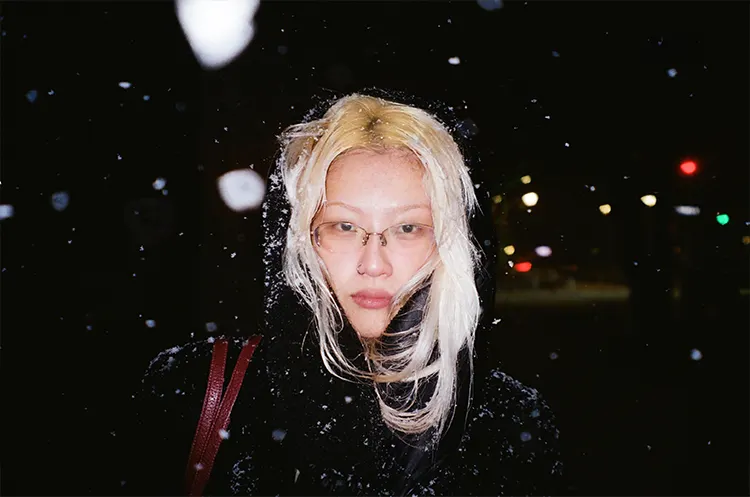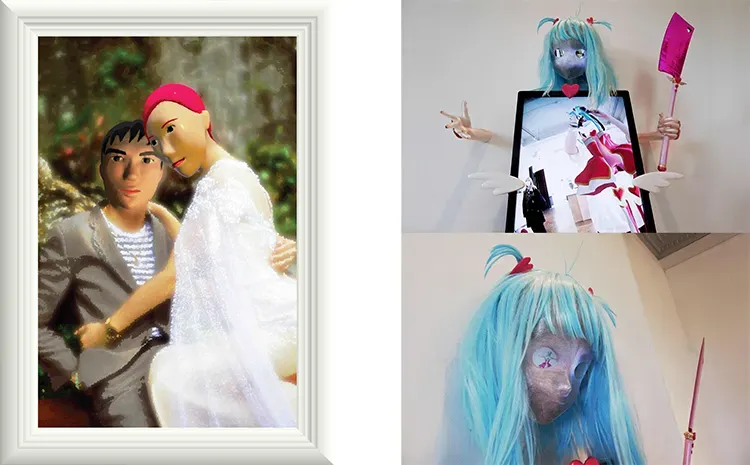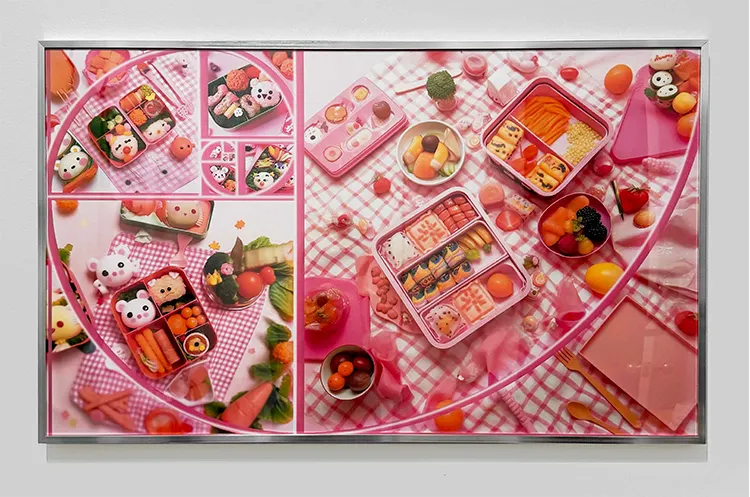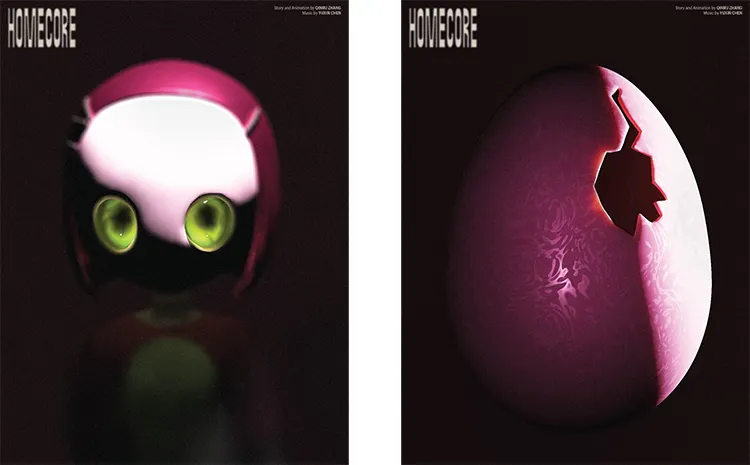“I enjoy transforming the familiar into something subtly unsettling, prompting viewers to engage with a quiet sense of unease.”

Bridging the Digital and the Tangible
Qinru Zhang is a multimedia artist and designer whose work seamlessly merges digital storytelling with physical installation. Based in New York, she graduated with Honors from the Rhode Island School of Design (RISD) in 2022, where she cultivated a strong interest in immersive narratives and digital media. Her practice focuses on themes of identity, femininity, and the uncanny, frequently examining how digital existence shapes self-perception. Growing up during China’s rapid urbanization and digital transformation, she developed a keen awareness of how technology intertwines with personal and collective identities. This cultural and technological shift played a crucial role in shaping her artistic vision, particularly her fascination with digital materials and synthetic aesthetics.
Zhang’s approach to storytelling is both delicate and unsettling, crafting narratives that blur the boundaries between reality and illusion. She often incorporates VR animation, 3D modeling, and mixed media installations to create immersive experiences that challenge conventional interpretations of femininity and selfhood. Her work engages with the contradictions of contemporary existence—where the digital offers both liberation and confinement, where beauty coexists with distortion. By reinterpreting familiar aesthetics into eerie, introspective compositions, she invites viewers to question the nature of identity in an increasingly virtual world.
Her exploration of digital media is driven by a desire to push beyond static visuals and create multidimensional experiences. What began as a foundation in traditional fine arts evolved into a deep engagement with interactivity, motion, and space. Zhang’s artistic journey has been shaped not only by personal experience but also by the evolving relationship between humanity and technology. By embracing experimentation and innovation, she continues to redefine the ways in which digital storytelling can reflect, distort, and reshape identity.

Qinru Zhang: Aesthetic Tensions and Conceptual Depth
Zhang’s artistic style is a careful balance between softness and discomfort, delicacy and distortion. She gravitates toward fluid, organic forms that contrast with eerie, unsettling elements, creating a visual tension that lingers in the mind of the viewer. This aesthetic sensibility is deeply connected to her thematic explorations of femininity, identity, and digital existence. Her work frequently examines how social structures influence self-perception, particularly in the context of gender expectations and the digital self. Rather than presenting identity as fixed or singular, she reveals its layered, shifting nature, often incorporating self-mirroring and identity fragmentation as recurring motifs.
A strong sense of uncanniness runs through Zhang’s practice, as she manipulates the familiar into something subtly foreign. Her work prompts a quiet unease, encouraging viewers to engage with the discomfort of recognizing yet not fully understanding an image, space, or figure. This dissonance reflects the contradictions inherent in digital identity—where one’s online persona can feel both intimately personal and strangely detached. Through her exploration of the blurred boundaries between organic and artificial, she raises questions about how technology redefines our understanding of the body, the self, and the spaces we inhabit.
Beyond digital aesthetics, Zhang also engages with materiality, often incorporating physical elements into her installations. By merging tangible materials with virtual environments, she reinforces the complex interplay between the real and the simulated. Her work does not simply depict digital existence; it actively immerses the viewer in its emotional and psychological effects. Whether through VR experiences, sculptural installations, or animated sequences, Zhang crafts environments that are at once intimate and alien, drawing attention to the fluid and often contradictory nature of contemporary identity.

Unraveling Memory and Perception in Homecore (2022)
One of Zhang’s most significant works, Homecore (2022), is a VR-based viewing experience that encapsulates many of the central themes in her practice. Rooted in Lacan’s Mirror Theory, the piece explores the tension between past and future, memory and reality, and self and others. It presents urban domesticity as both an illusory and inescapable site of self-reflection, questioning the boundaries between physical space and psychological confinement. The narrative follows a 12-year-old girl caught in a repetitive daily routine, where the use of VR heightens rather than alleviates her sense of entrapment.
Unlike traditional VR experiences that emphasize exploration and freedom, Homecore inverts this expectation. The viewer, embodying the girl’s perspective, is confined within an environment that loops back on itself, reinforcing the paradox of perceived agency versus actual restriction. This design choice mirrors the psychological entrapment of urban existence, where routine and familiarity can become indistinguishable from constraint. The piece challenges the assumption that digital spaces inherently offer escape, instead suggesting that they can deepen cycles of introspection and enclosure.
The significance of Homecore lies in its ability to evoke an emotional and psychological response from its audience. Exhibited in multiple cities, including New York and Providence, the work has received awards such as The Bridge Video Award and the MUSE Creative Gold Award. Viewers have described experiencing the same eerie, claustrophobic sensation that Zhang sought to convey, demonstrating the power of immersive storytelling in shaping perception. By using VR to challenge expectations of digital space, Homecore exemplifies Zhang’s ability to craft experiences that are both conceptually rigorous and emotionally resonant.

Qinru Zhang: Expanding the Boundaries of Artistic Practice
Zhang’s artistic influences span multiple disciplines, reflecting her interdisciplinary approach to storytelling. She draws inspiration from artists such as Cao Fei, Louise Bourgeois, and Ian Cheng, each of whom has shaped her understanding of narrative, materiality, and digital existence. Cao Fei’s exploration of virtual worlds and digital identities resonates with Zhang’s interest in speculative storytelling and self-perception. The way Cao Fei blends reality and fiction into immersive, thought-provoking narratives directly aligns with Zhang’s own conceptual inquiries.
Louise Bourgeois has played a critical role in shaping Zhang’s perspective on psychological spaces and emotional materiality. Bourgeois’ ability to translate personal memory and trauma into sculptural forms informs Zhang’s approach to constructing immersive environments. The use of organic structures and themes of self-reflection in Bourgeois’ work deeply align with Zhang’s own explorations of the uncanny and the feminine body. Similarly, Ian Cheng’s evolving digital ecosystems have influenced Zhang’s thinking about the fluidity of identity and the agency of digital beings. His work challenges traditional notions of static art, emphasizing unpredictability and interactivity—concepts that are central to Zhang’s own practice.
Looking ahead, Zhang continues to push the boundaries of digital storytelling, seeking new ways to merge physical installations with virtual avatars. She is particularly interested in exploring fragmented identity through immersive experiences, where viewers navigate between digital and physical versions of themselves. This project-in-development reflects her ongoing commitment to questioning how we construct and perceive identity in an increasingly technologized world. By balancing innovation with emotional depth, Zhang’s work challenges audiences to rethink their relationship with the digital, the artificial, and ultimately, themselves.

The post Qinru Zhang: The Uncanny Beauty of Digital Self-Perception appeared first on AATONAU.
+ There are no comments
Add yours